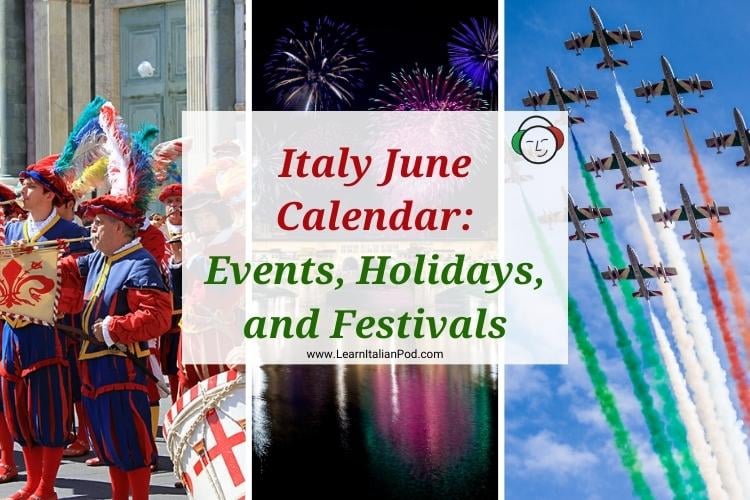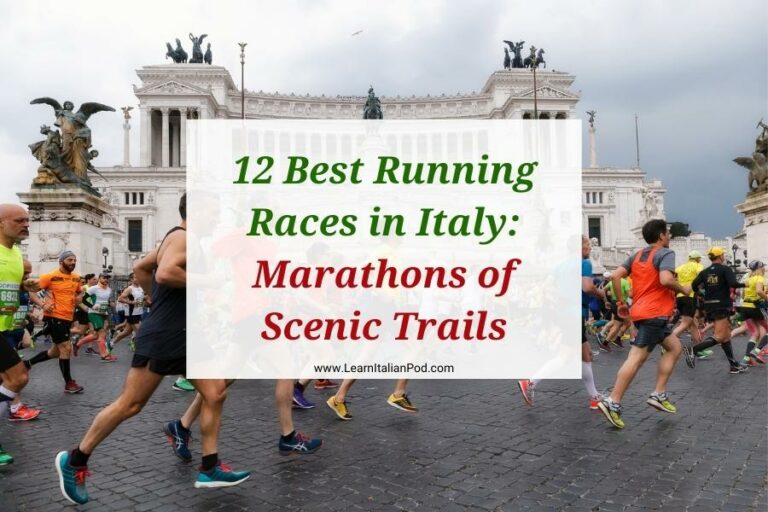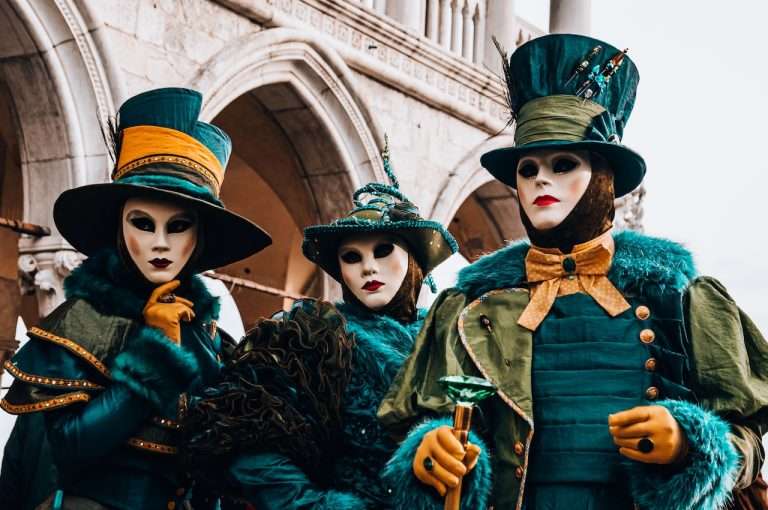What is Italy Known For? 100 Things That Make Italy Famous

Ciao a tutti, Italian culture lovers! It’s Max here, ready to help you discover what makes “il Bel Paese” extraordinary. Have you ever wondered, “What is Italy famous for?” Let’s find out together.
Italy is known for its rich tapestry of history, art, and gastronomy, weaving a story that spans millennia. Prepare to explore a list of 100 illustrious facets that render Italy famous worldwide.
Italian Food and Drink: Flavors Italy is Known For
Italy is famous for its cuisine, which is celebrated worldwide for its bold flavors and culinary diversity. Every dish, from a slice of pizza to a scoop of Italian gelato, tells a story of the country’s rich cultural heritage.
Here’s an exploration of Italy’s most famous food and drinks that have made the country a food lover’s paradise.
1. Pizza
Pizza, particularly from Naples, has become an international symbol of Italian cuisine. Neapolitan pizza typically has a thin, soft crust with a slightly chewy texture, elaborate with classic toppings like tomatoes, mozzarella cheese, and basil, representing the colors of the Italian flag.
Craving for more pizza knowledge? Read 110 Fun Facts About Pizza: A Slice of Global Culture.
2. Pasta
Pasta is synonymous with Italian food. Each region has its own specialties, ranging from spaghetti Bolognese in Tuscany to penne alla vodka in Rome.
Fresh pasta, like tagliatelle and ravioli, served in Florence, highlights the emphasis on locally sourced ingredients and traditional techniques. In case you’re wondering, here are the most popular Italian pasta brands.
3. Espresso (Caffè)

Rich and potent, espresso, or “caffè” as it’s simply known in Italy, is much more than a coffee. It’s an integral part of Italian culture.
The strong espresso shot is a staple nationwide, often consumed while standing at the bar, swiftly recharging for the day ahead. If you’re curious, here are the top picks for Italian coffee brands.
4. Cappuccino
Your breakfast in Italy isn’t complete without a frothy cappuccino. This beloved coffee beverage, equal parts espresso, steamed milk, and milk froth, is a morning tradition, savored mostly before 11 am in cozy cafés.
Pro Tip: In Italy, ordering a cappuccino after 11 am is the espresso-way to stand out as a tourist!
5. Gelato
A creamy gelato is a must-have when you walk the lanes of Rome on a warm day. This Italian ice cream is denser and more flavor-concentrated than its counterparts, with various delicious flavors ranging from traditional vanilla and chocolate to unique regional favorites like Sicilian pistachio.
6. Tiramisù

Tiramisù, meaning ‘pick me up’ in Italian, is a luxurious dessert made with coffee-soaked ladyfingers and a rich mascarpone cheese mixture. A dusting of cocoa powder completes this indulgent treat, which has roots in the Veneto region.
7. Italian Cheese
Italian cheese, such as mozzarella, pecorino, and gorgonzola, are cornerstones of Italian food. Whether it’s the fresh mozzarella on a Caprese salad or the sharp bite of pecorino in a Roman pasta dish, each cheese imparts a unique flavor profile endemic to its origin.
8. Italian Wine
Italy’s wine heritage stretches back millennia, and regions like Tuscany and Sicily are world-renowned for their vineyards. Enjoy a glass of bold Chianti or a delicate Prosecco and savor the legacy of Italian winemaking traditions.
9. Olive Oil

Olive oil is the foundation of Italian cooking. From the groves of Tuscany, high-quality extra virgin Italian olive oil is prized for its fruity flavor and peppery finish, perfect for drizzling over bruschetta or mixing into a vinaigrette.
10. Risotto
The creamy, comforting risotto originates in Northern Italy and is revered for its ability to marry flavors like saffron in risotto alla Milanese or seafood in coastal varieties. Arboreal rice creates the dish’s signature texture, absorbing the rich stock and wine as it cooks.
11. Cannoli
Tubular shells of fried pastry dough, filled with a sweet, creamy filling typically incorporating ricotta, define cannoli. Originating from Sicily, these treats are a staple in Italian bakeries and are often garnished with chocolate chips or candied fruit.
12. Limoncello
Hailing from the Amalfi Coast, limoncello is a zesty, sweet liqueur made from the zest of Sorrento lemons. It’s traditionally served chilled as an after-dinner digestivo, washing down a sumptuous meal with its bright, citrus flavor.
13. Italian Truffles
The rare and luxurious Italian truffles, particularly from regions such as Piedmont, add a touch of opulence to Italian cuisine. Shaved over pasta, risotto or served alongside bold cheeses, truffles exude an earthy aroma that elevates any dish they accompany.
Iconic Italian Cities and Regions: What Makes Italy Famous
Italy boasts many destinations offering rich history, unique culture, and breathtaking landscapes. Each city and area contributes significantly to Italy’s charm, attracting tourists from around the globe.
14. Rome (Roma)
In the heart of Italy lies Rome, the must-visit Eternal City with a history that spans over two and a half thousand years.
As a former epicenter of the Roman Empire, its streets are lined with iconic landmarks, like the Colosseum and Vatican City, making it a treasure trove for history and culture enthusiasts. How well do you know Rome? Take the quiz and find out!
15. Florence (Firenze)
Florence, the cradle of the Renaissance, is celebrated for its art, architecture, and influence on culture. The city is home to Michelangelo’s David and the awe-inspiring cathedral, Santa Maria del Fiore, commonly known as the Duomo.
16. Venice (Venezia)

The canal-woven city of Venice is an archipelago of 118 islands connected by over 400 bridges. Your trip here wouldn’t be complete without a gondola ride along its waterways, witnessing the grandeur of St. Mark’s Basilica and the charm of Rialto Market.
17. Milan (Milano)
Milan is Italy’s fashion powerhouse, where contemporary chic meets historical elegance. Beyond its iconic Fashion Week, a pivotal event in the global fashion scene, Milan dazzles with treasures like the stunning Milan Cathedral and Leonardo da Vinci’s masterpiece, The Last Supper.
18. Cinque Terre
Nestled on the rugged coast of Liguria are the five picturesque villages of Cinque Terre. Their colorful houses and terraced vineyards are part of a UNESCO World Heritage site and offer spectacular seaside views and trails for adventurous souls.
19. Amalfi Coast
The Amalfi Coast is a 50-kilometer stretch of coastline renowned for its dramatic cliffs, pristine beaches, and charming towns like Positano and Amalfi. It’s a perfect blend of natural beauty and historical architecture.
20. Italian Lakes
The Italian Lakes district, renowned for its serene beauty, encompasses Lake Como, Lake Garda, and Lake Maggiore. Known for their opulent villas and tranquil waters, these lakes offer a peaceful retreat against the stunning backdrop of the Alps, blending natural splendor with luxurious living.
21. Tuscan Countryside
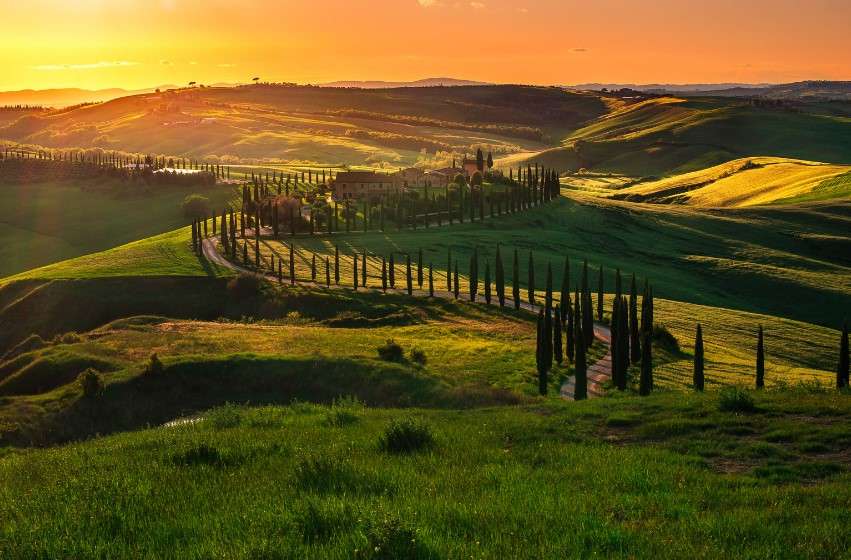
Tuscany’s countryside is a symphony of rolling hills, olive groves, and vineyards. It is the essence of Italian rural elegance, with historic towns like Siena and Florence punctuating the landscape.
22. Pompeii (Pompei)
Near Naples, the ancient city of Pompeii offers a somber yet fascinating glimpse into Roman life, frozen in time by the eruption of Mount Vesuvius in AD 79. This catastrophic event preserved the city in ash, providing an unparalleled archaeological snapshot of ancient daily life.
23. Sicily
As the largest island in the Mediterranean, Sicily has seven UNESCO World Heritage Sites, including ancient Greek temples, Norman churches, and Baroque palazzi. This island’s rich cultural tapestry is complemented by dramatic landscapes like Mount Etna, one of Europe’s tallest active volcanoes.
24. Naples (Napoli)
Naples is famed for its rich history, colorful street life, and being the birthplace of pizza. This vibrant city also serves as a gateway to destinations like the ruins of Pompeii and the idyllic island of Capri.
Famous Italian Landmarks and Tourist Sites
Things Italy is famous for are epitomized in its landmarks and tourist sites, which are essential for anyone visiting Italy.
These places, from remnants of the Roman Empire to masterpieces of the Renaissance, represent the nation’s rich history, art, and architecture, offering a profound encounter with its storied past.
25. Colosseum
The Colosseum is an iconic symbol of ancient Roman grandeur in Rome’s heart. This imposing structure, one of the most famous landmarks worldwide, was once capable of seating 50,000 spectators and hosted gladiatorial contests and public spectacles.
26. Vatican City
Nestled within Rome, Vatican City stands as the heart of Italy’s spiritual heritage, serving as the epicenter of Catholicism. This sacred enclave is adorned with sites like St. Peter’s Basilica and the Vatican Museums, home to Michelangelo’s awe-inspiring Sistine Chapel.
27. Vatican Museums
Step into the Vatican Museums in Rome, a sprawling art and history complex including the iconic Sistine Chapel.
The museums are a treasure trove of artwork from antiquity to the modern day, much of which was collected by the popes over centuries. They also include some of the most important pieces of Renaissance art.
28. Leaning Tower of Pisa

The Leaning Tower of Pisa, known globally for its unintended tilt, is an extraordinary example of Romanesque architecture and one of the world’s most recognizable structures.
29. Venice Canals
Venice Canals are the veins through which the lifeblood of Venice flows. A gondola ride through the Grand Canal offers views of opulent palazzos and the essence of Venetian luxury.
30. Rialto Bridge
Over the Grand Canal, the Rialto Bridge is Venice’s oldest bridge and a bustling marketplace epitomizing Venetian commercial history and its relationship with global trade.
31. Ponte Vecchio
Florence’s Ponte Vecchio is a medieval stone arch bridge decked with shops, a testament to Florence’s medieval prowess in commerce and culture.
32. Piazza della Signoria (Florence)

The Piazza della Signoria is Florence’s grand square, fringed with historic buildings and sculptures, including a replica of Michelangelo’s David, symbolizing the Republic of Florence’s strength.
33. Uffizi Gallery
Florence’s Uffizi Gallery houses an unmatched collection of Italian Renaissance art. As you peruse its halls, you’ll encounter works by almost every notable Renaissance painter, including Leonardo, Michelangelo, and Raphael. This offers a comprehensive view of an era that reshaped the art world.
34. Milan Cathedral
The Milan Cathedral, or Duomo di Milano, exemplifies Gothic architecture. Its forest of spires and statues dominates the skyline, a monument to divine splendor and human artistry.
35. Trevi Fountain
The Trevi Fountain in Rome, an ornate baroque masterpiece, is where tossing a coin over your shoulder promises a return to the Eternal City. Legend has it that approximately 3,000 euros are thrown into the fountain daily, funding charitable activities in the local community.
36. Verona Arena
In Verona, which makes an ideal one-day trip, the well-preserved Verona Arena echoes with memories of ancient Roman triumphs. This amphitheater, which once hosted gladiatorial games, now stages open-air operas.
37. Trulli of Alberobello
In Puglia, located in Southern Italy, the Trulli of Alberobello are unique conical stone huts, symbols of the rural architectural ingenuity specific to Italy’s Tuscany region.
Famous Italian Natural Landmarks
Italy’s diverse landscape encompasses some of the world’s most stunning natural landmarks. From smoldering volcanoes to lush mountains and pristine coastlines, Italy’s nature offers breathtaking views and unique geological formations that have thrilled visitors for centuries.
38. Mount Etna

Mount Etna, Europe’s highest and most active volcano, is a towering presence on the island of Sicily. Standing over 3,300 meters, its frequent eruptions carve new landscapes, and its rich soils near the base support lush vineyards.
39. Mount Vesuvius
The infamous Mount Vesuvius looms over the Bay of Naples. Known for the catastrophic eruption in 79 CE that entombed Pompeii and Herculaneum, it’s a stark reminder of nature’s power that you can witness firsthand.
40. Dolomites Mountains
The Dolomites Mountains, a UNESCO World Heritage site, offer some of Italy’s most spectacular sights. This mountain range in the northern Italian Alps invites you to experience its soaring peaks, a paradise for hiking and winter sports.
Suggested Read: 10 Best Italian Ski Resorts for Families
41. Amalfi Coast Coastline
On the southern edge of the Sorrentine Peninsula, the Amalfi Coast’s cliffside villages and turquoise waters will captivate you. The coastline’s dramatic beauty, incorporating nature and quaint human settlements, makes it a jewel of Italy.
42. Hot Springs (Saturnia)

The cascading hot springs of Saturnia are a marvel in the heart of Tuscany. These thermal waters, rich in sulfur and other minerals, offer a therapeutic and relaxing dip with the added charm of Tuscan landscapes as your backdrop.
43. Val d’Orcia
Val d’Orcia, another Tuscan treasure (yet another UNESCO World Heritage site), is defined by its rolling hills, cypress trees, and vineyards. This idyllic valley, which changes hues with the seasons, has inspired painters and photographers seeking the essence of Tuscany’s bucolic landscapes.
44. Lake Como
Nestled at the foot of the Alps, Lake Como is a haven of tranquility and a playground for the elite. Its deep glacial waters, surrounded by palatial villas and gardens, provide a serene escape alongside opportunities for water sports and mountain trekking.
Italian Fashion Designers and Luxury Brands

Italy is renowned for its exceptional contribution to the fashion world, with Milan being the heart of Italian fashion.
Here, luxury, elegance, and groundbreaking design merge to produce some of the world’s most recognized and celebrated fashion designers and brands.
45. Gucci
Gucci is a pinnacle of Italian luxury, known for its iconic double-G logo and interlocking patterns. Founded in Florence in 1921, Gucci’s blend of tradition and innovation appeals to a diverse clientele, including a significant following among celebrities.
46. Valentino
Valentino is synonymous with pure elegance and is famed for its red dresses, a distinct color known as “Valentino red.” Since 1960, Valentino has been a staple in high fashion, crafting luxurious garments embodying timeless sophistication.
47. Versace
Versace’s bold and glamorous designs make it a symbol of Italian luxury. Since 1978, this brand has been associated with its Medusa head logo and distinctively vibrant prints, exuding confidence and a daring fashion sense.
48. Giorgio Armani
Giorgio Armani is recognized for revolutionizing the fashion industry with his understated and sophisticated menswear lines. Debuting in 1975, Armani’s designs are celebrated for clean tailoring and luxurious materials, often preferred by professionals for a polished look.
49. Dolce & Gabbana
Dolce & Gabbana delivers opulent and flamboyant fashion, often inspired by Italy’s diverse culture and history. Since 1985, they have combined modern luxury with classic Italian flair in their widely sought-after apparel.
50. Prada
Prada’s innovation in design has solidified its standing as a leading brand in the fashion industry. Known for its minimalist style and high-quality materials, Prada redefines luxury fashion with its unique and thought-provoking aesthetics.
51. Fendi
Emanating Rome’s grandeur, Fendi has been at the forefront of the fur and leather goods market since 1925. Recognized for its impeccable craftsmanship and the timeless Baguette bag, Fendi successfully merges traditional artisan skills with fashion-forward innovation.
Suggested Read: Discover the captivating world of the best Italian brands.
Famous Italian Car Brands
Italy is renowned for its precision engineering and design tradition, particularly in the automotive industry. The names of the Italian car brands resonate with luxury, speed, and elegance, creating an unrivaled legacy in the motoring world.
52. Ferrari

Ferrari is the epitome of Italian luxury sports cars. Enzo Ferrari founded the company in 1947; since then, it has been synonymous with high performance and prestige.
Known for its distinctive prancing black horse on a yellow background logo, Ferraris are a staple on both the track and the street, sought after for their unparalleled speed and craftsmanship.
53. Lamborghini
Ferruccio Lamborghini started Lamborghini in 1963 to compete with established brands like Ferrari. Famous for their aggressive styling and V12 engines, Lamborghini cars are icons of luxury and power.
Models like the Aventador and Huracán are typical examples of the brand’s dedication to high performance and bold aesthetics.
54. Maserati
Since 1914, Maserati has produced vehicles that are noted for their elegance and speed. Originally focused on racing cars, Maserati has evolved to combine race-bred performance with high-end grand touring luxury, giving you cars like the Quattroporte and the GranTurismo that blend speed with comfort and style.
55. FIAT
FIAT (Fabbrica Italiana Automobili Torino) was established in 1899 and is one of Italy’s oldest car manufacturers. While FIAT may be less synonymous with luxury, it offers practicality and is celebrated for models like the FIAT 500, which has become an icon of Italian design and urban mobility.
56. Alfa Romeo
Alfa Romeo‘s racing heritage informs its current lineup of high-performance vehicles. Known for their beauty and Italian flair, Alfa Romeo’s cars, such as the Giulia and Stelvio, fuse style with performance, providing a premium driving experience.
57. Vespa (Piaggio)

Beyond cars, Italy is famous for the iconic Vespa, produced by Piaggio in 1946. This classic Italian scooter has become a symbol of stylish personal transport, offering a mix of design, practicality, and culture that no other two-wheeler can claim.
Love Vespas and visiting Florence? Read Best Vespa Tours from Florence: a fun-filled way to discover Tuscany’s beauty.
Iconic Italian Art and Artists
Italy is home to revered artists and world-class museums, a key reason why Italy is famous and a highlight of any trip to Italy.
The nation’s art scene is timeless and transcendental, marked by iconic figures like Leonardo da Vinci and Michelangelo, who represent the zenith of Renaissance creativity. Let’s explore the masterpieces and institutions that stand as pillars of Italian heritage.
58. Leonardo da Vinci
Leonardo da Vinci was a polymath whose genius pervaded various fields. However, he is best known for his works ‘The Last Supper’, painted in Milan, and the ‘Mona Lisa’, the crown jewel of the Louvre.
Yet, your exploration of da Vinci’s mastery is incomplete without visiting the Vinci region in Florence, where you can immerse yourself in his life and art.
59. The Last Supper (Milan)
Housed within Milan’s Convent of Santa Maria delle Grazie, The Last Supper is Leonardo da Vinci’s legendary fresco that exemplifies the zenith of artistic achievement during the Italian Renaissance.
60. Michelangelo

Michelangelo is synonymous with Renaissance art. His sculptures, ‘David‘ and ‘Pieta,’ exemplify his talent. Both are housed in Italy—David in the Accademia Gallery in Florence and the Pieta in St. Peter’s Basilica in Vatican City. Beyond sculpture, his Sistine Chapel ceiling frescoes are a testament to his mastery of painting.
61. Raffaello
Raffaello Sanzio, known as Raphael, left an indelible impact with his paintings which epitomize the High Renaissance.
You can admire his detailed compositions and graceful figures in works such as the ‘School of Athens’ in the Vatican Museums. His refined technique became a guiding example for subsequent generations of artists.
62. Botticelli
Sandro Botticelli’s paintings are celebrated for their ethereal quality and emblematic portrayal of mythological themes. ‘The Birth of Venus‘ and ‘Primavera‘ are iconic works that capture the merging of myth with a distinctive, florid style. They can be found in the extensive collection of the Uffizi Gallery in Florence.
63. Caravaggio
A master of chiaroscuro, Caravaggio brought dramatic realism to his subjects. His paintings, such as ‘The Calling of St Matthew,’ display a powerful grasp of light and shadow to evoke emotion. You’ll find some of his most important works in Rome, within churches such as San Luigi dei Francesi or the Vatican Museums.
Famous Italian History and Culture
Italy’s tapestry of history and culture is rich with world-renowned contributions to art, architecture, science, and music. From the intellectual awakening of the Renaissance to the grandeur of the Roman Empire, each period has left indelible marks that continue to influence the world.
64. The Renaissance
The Renaissance was a period of immense cultural and artistic growth that began in Florence. You can explore the artworks of Michelangelo, Leonardo da Vinci, and Raphael, which exemplify the innovation and skill of this period.
This era propelled culture, science, and philosophy forward, reshaping Europe’s intellectual landscape.
65. Roman Empire
The Roman Empire dominated the ancient world, with Rome at its heart. It was known for significant achievements in law, governance, engineering, and military conquests.
The Colosseum and the Forum in Rome stand as monuments to the empire’s grandeur, drawing millions of visitors every year who wish to walk in the footsteps of Roman emperors and gladiators.
Suggested Read: 10 Famous Latin Quotes and Meanings
66. Italian Language
The Italian language, arising from Latin and enriched through centuries of literature and poetry, has spread its melody across the globe.
Dante’s “Divine Comedy,” written in vernacular Italian, was instrumental in establishing the standard Italian language and is a cornerstone of Italy’s literary heritage. – Fancy a chat in Italian? Start your journey here.
67. Opera (La Scala, Verdi)

Italian opera, pulsating with dramatic intensity, is an emotional exploration of the human soul. La Scala in Milan is one of the most prestigious opera houses in the world.
An iconic composer, Giuseppe Verdi symbolized Italy’s unification and national identity through his music, which remains central to the country’s operatic scene.
68. La Dolce Vita
“La Dolce Vita,” or “The Sweet Life,” encapsulates the essence of Italian lifestyle—a celebration of the joys of everyday life. This approach to living, illustrated in Federico Fellini’s film of the same name, emphasizes beauty, leisure, and passion.
69. Piazzas and Public Squares

Italian piazzas are open-air museums that tell stories of civic engagement and cultural festivities.
With their unique shell shape, the Piazza del Campo in Siena and St. Peter’s Square in Vatican City, designed by Bernini, are magnificent examples of urban spaces that foster communal bonds.
Each square is a confluence of history, culture, and social life, signifying the heartbeat of Italian identity.
Famous Italian Inventors and Explorers
Italy has been home to some of the world’s most remarkable inventors and explorers, whose contributions have profoundly shaped history and science.
70. Alessandro Volta
You may recognize the unit of electrical potential, the volt, which honors the inventor Alessandro Volta. He is credited with inventing the voltaic pile, the precursor to the electric battery, which dramatically transformed the field of electricity.
71. Guglielmo Marconi
The name Guglielmo Marconi is synonymous with wireless communication. His groundbreaking work led to the development of the radio, which not only reshaped global communication but also earned him the Nobel Prize in Physics.
72. Galileo Galilei
Galileo Galilei is a cornerstone in both the history of science and the Italian Renaissance culture. His telescopic observations affirmed the heliocentric model, and he is also known for his improvements to the telescope. Learn more about Galileo’s pivotal role in developing the scientific method.
73. Amerigo Vespucci
The Americas owe their name to the explorer Amerigo Vespucci. His voyages to the New World demonstrated that Brazil and the West Indies were not Asia’s eastern outskirts, as Columbus initially conjectured.
Suggested Read: 10 Famous Italian Explorers Who Changed History
74. Cristoforo Colombo
Better known as Christopher Columbus, Cristoforo Colombo embarked on expeditions that eventually led to the European awareness of the American continents. His journeys marked a significant historical point, precipitating major global exploration and trade shifts.
75. Marco Polo
Your imagination of the Silk Road might be incomplete without considering Marco Polo, whose travels to China were documented in “The Travels of Marco Polo.” His detailed accounts offered Europe a new perspective on Asian culture and commerce.
Famous Italian Musicians and Composers
Italy’s rich cultural heritage is profoundly reflected in its music, with a tradition steeped in opera and classical composition. Your exploration of Italian culture would be incomplete without recognizing the maestros whose works have become synonymous with Italian artistry.
76. Giuseppe Verdi
Giuseppe Verdi stands as a monumental figure in opera. His works, such as La Traviata and Rigoletto, are cornerstones of the operatic canon, noted for their emotional depth and melodious scores that reflect the complexities of the human spirit.
77. Antonio Vivaldi
Antonio Vivaldi, celebrated for his virtuosic violin concertos, particularly The Four Seasons, was an Italian Baroque composer who left a lasting mark on the evolution of violin performance.
His compositions are characterized by their rhythmic vitality and use of melody to convey the richness of Italian musical tradition.
78. Rossini
Gioachino Rossini is your quintessential operatic mastermind, credited with creating the bel canto style that dominated Italian opera in the early 19th century. Pieces like The Barber of Seville command global admiration for their lively orchestration and memorable arias.
79. Puccini
Giacomo Puccini carried the Italian operatic legacy into the late 19th and early 20th centuries with classics such as La Bohème and Tosca. His operas are adored for their powerful dramatic narratives and lush, textured compositions, which pull at your emotions and immerse you in the theatrical experience.
80. Antonio Stradivari
Antonio Stradivari, the creator of the “Stradivarius” violins, is synonymous with unparalleled quality and sound instruments.
Crafted in the 17th and 18th centuries, Stradivari’s violins represent the pinnacle of stringed instrument construction, and they’re famed for their exceptional tonal quality and exquisite craftsmanship.
Famous Italian Writers and Poets
Italy’s cultural landscape has been immensely enriched by its literary giants, who have contributed significantly to literature and the Italian language.
81. Dante Alighieri
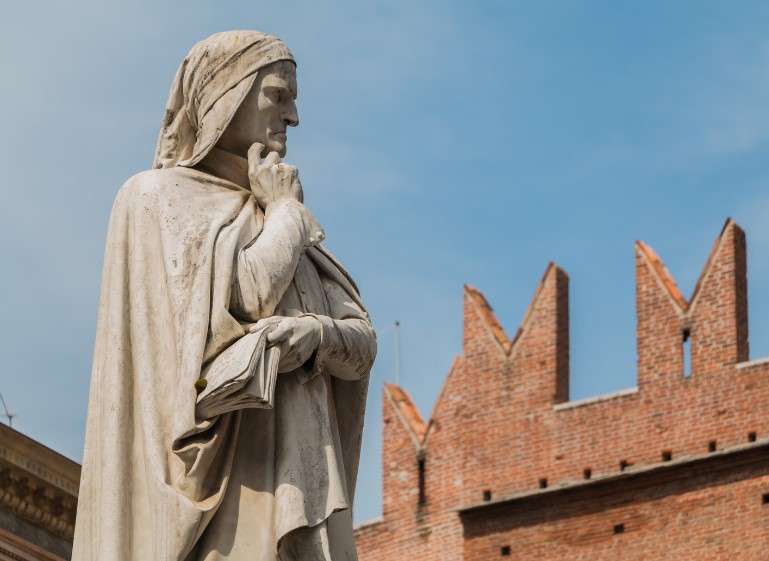
Dante Alighieri is celebrated as the “father of the Italian language” and is a central figure in Italy’s literary tradition. His magnum opus, The Divine Comedy, remains a towering pinnacle in world literature and is essential to the evolution of the Italian language.
82. Petrarch
Francesco Petrarca, known as Petrarch, is revered for laying the groundwork for Renaissance humanism. His creation of the Petrarchan sonnet has deeply influenced the world of poetry, and his collection of Italian lyric poems, “Canzoniere,” solidified his position as one of Italy’s most significant poets.
83. Boccaccio
Giovanni Boccaccio is another cornerstone of Italian culture. He is best known for “The Decameron,” a classical literary work that presented a collection of novellas. Boccaccio’s influence is apparent in Italian literature, shaping the Italian vernacular prose style.
Suggested Read: 17 Best Italian Books: Explore Italy’s Rich Culture
84. Umberto Eco
Umberto Eco was a modern literary figure who made notable contributions to works like The Name of the Rose. This work blends medieval studies, semiotics, and literary theory, reflecting the rich tapestry of Italy’s cultural heritage.
85. Primo Levi
Primo Levi’s body of work transcends literature—it is a profound exploration of human experience. His powerful memoir “If This Is a Man,” detailing his survival in Auschwitz, is a crucial narrative within Italian culture and global history.
Famous Italian Sports and Events
Italy’s contributions to sports are culturally significant and historically rich. The country’s passion for football, excellence in motor racing, and revered cycling events have shaped Italy’s national identity and profoundly impacted the global stage.
86. Italian Football (Calcio)
Football, or Calcio as it’s known in Italy, is a beacon of national pride and fervor. You’re witnessing a legacy over a century with the Italian national team, Azzurri, having won four FIFA World Cup titles. The sport runs deep in Italian veins, uniting local communities and igniting national passion.
87. Ferrari in Formula 1
Italy is synonymous with the elegance and speed of Ferrari, a dominant name in Formula 1 racing. When you see a Ferrari’s iconic red, you see a piece of Italian excellence and an enduring symbol of luxury and performance. Ferrari has claimed numerous championships, making it an enduring competitor in F1.
88. Giro d’Italia (Cycling)
The Giro d’Italia is among the most grueling and revered cycling events worldwide. You may be familiar with the Tour de France, but Italy’s version is equally spectacular.
It features breathtaking landscapes and challenging terrains that test every cyclist’s endurance. This three-week race has been generating excitement since 1909.
89. AC Milan and Juventus (Football Clubs)
Two of Italy’s most successful football clubs, AC Milan and Juventus, have carved out formidable presences in Italian and European football. As a fan, you are looking at teams that boast over 50 league titles and numerous accolades in UEFA competitions, embodying the strength and spirit of Italian football.
Famous Italian Films and Cinema
Italian cinema has impacted the world stage, deeply intertwined with the country’s culture and history. Some of the most iconic Italian films have explored themes ranging from the allure of Rome’s high society to the dramatic tales of the mafia.
90. La Dolce Vita
La Dolce Vita, directed by Federico Fellini, captures a series of stories across Rome’s vibrant landscape. The film examines the “sweet life” of the city’s elite. It is often heralded for its critique of celebrity culture, offering a window into the hedonistic lifestyle of the Italian upper class during the economic boom.
91. Spaghetti Westerns
Spaghetti Westerns represent a subgenre of Western films that emerged in the 1960s. Directors like Sergio Leone pushed the boundaries of the genre with movies such as “The Good, The Bad, and The Ugly,” characterized by their dramatic storytelling and striking visuals—elements that celebrated Italian filmmaking.
92. The Godfather Trilogy
Although an American production, The Godfather Trilogy is deeply rooted in Italian culture and has left a profound imprint on cinema worldwide. Directed by Francis Ford Coppola, these films explore the complex dynamics within a mafia family, offering insight into organized crime that resonates with global audiences.
Suggested Read: Only True Italian Movie Buffs Can Ace This Epic Trivia Quiz
93. La Vita è Bella
Roberto Benigni’s La Vita è Bella (“Life is Beautiful”) fuses humor and tragedy to portray the harrowing experience of a Jewish Italian waiter during World War II. This poignant film won international acclaim, crystallizing the Italian spirit amidst historical adversity.
94. Cinema Paradiso
Giuseppe Tornatore’s Cinema Paradiso is a love letter to film itself. This nostalgic piece delves into the relationship between a young boy and a movie projectionist in Sicily. Its tender reflection on friendship and film’s impact on childhood captured hearts worldwide.
Italian Lifestyle and Social Culture
The Italian lifestyle is a unique tapestry of family traditions, expressive communication, artistic excellence, and convivial gatherings that pervade everyday life. In Italy, these cultural elements are not just practices but interwoven into the country’s identity.
95. Family (Famiglia)
Family is the cornerstone of Italian culture. Italian families often have strong bonds, with multiple generations living together or nearby. In many households, family members frequently gather for large meals, especially on Sundays and holidays, when la Famiglia is enthusiastically celebrated.
96. Speaking with Hands

Italians are known for their expressive hand gestures when communicating. Over 250 hand movements convey various emotions, messages, and emphasis, making conversations vibrant and almost theatrical. This form of nonverbal communication is an integral part of Italian culture.
97. Italian Design and Craftsmanship
Italians take pride in their sense of style and the quality of their craftsmanship. Italy’s reputation for design excellence can be seen in its fashion, furniture, cars, and various artisan products. The attention to detail and the blend of tradition with innovation result in highly desired products worldwide.
98. Espresso Bars and Coffee Culture
Coffee is a way of life in Italy, with espresso bars on almost every corner. These establishments are the social hubs of Italian cities, where a caffè is savored for the beverage and the social interaction it brings. Whether standing at the bar or sitting at a table, enjoying an espresso is a cherished Italian ritual.
99. Aperitivo and Social Life
The aperitivo, or Italian happy hour, is an important social tradition in Italy. Typically enjoyed from late afternoon into early evening, it’s an opportunity to relax with friends over light drinks like Prosecco or Aperol Spritz, accompanied by small bites. This pre-dinner ritual encapsulates the Italian approach to leisure and camaraderie.
100. Italian Festivals and Traditions
Italians celebrate yearly festivals and traditions marked by parades, religious processions, and community feasting. Carnivals, such as Carnevale di Venezia, and historical reenactments, like Il Palio di Siena, are steeped in history and reflect Italy’s regional diversity as much as its unified cultural identity.



